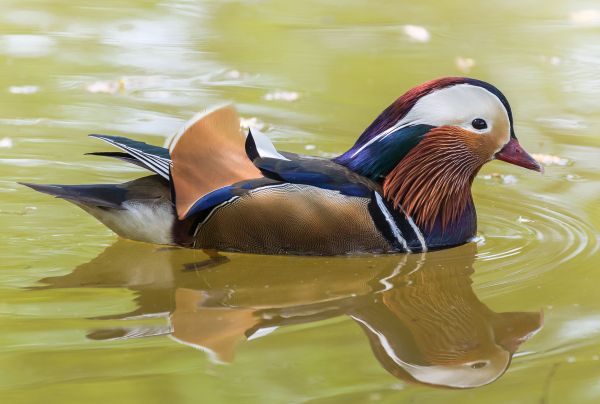I generally don’t think much about ducks. Mallards are the ones I’m most familiar with, and though they’re pretty, I’ve seen them so often I don’t pay much attention to them. Mandarin ducks, though — they are ducks you take notice of. I can’t imagine a more colourful, eye-catching duck. Maybe rainbow ducks, but I’m pretty sure those don’t exist.

Mandarin ducks are native to East Asia, though there are also introduced populations in the UK and US. They are migratory, breeding in Siberia, China and Japan, and heading to southern China and Japan for the winter. Mandarin ducks prefer to nest in dense forest areas, around rivers and lakes. In the winter the ducks can be found in marshes, flooded fields, as well as occasionally in costal lagoons and estuaries.
As I mentioned, Mandarin ducks are quite colourful. Well, the males are bright and beautiful, and the females are rather drab. I’m not even going to try and accurately describe a male Mandarin duck’s vibrant plumage — that’s what pictures are for! Females are mostly grey with a white stripe behind their eyes. Mandarin ducks don’t reach particularly impressive sizes, measuring 41-49 cm long with wingspans of up to 75 cm.

Mandarin ducks feed primarily on plants and seeds, foraging both on land and in water. During the winter, seeds and grains form the bulk of the ducks’ diets; in spring and summer they eat more animal-based diets, including insects, snails, fish and frogs. They are crepuscular, feeding at dawn and dusk and roosting during the day.
Male Mandarin ducks use their bright colours to attract females, though they also perform courtship rituals that include strange behaviours such as mock drinking and shaking. Once a pair bond is formed, it can last for multiple seasons. Both parents search for a nesting site, though females get the last say in where they finally settle down. Between nine to twelve eggs are laid in the nest, and are incubated by the female for about a month. Male Mandarin ducks may protect females and eggs during incubation, but they do not help with incubation, and leave before the eggs hatch.

Mandarin ducks start life in a bit of a quandary. They’ve just hatched, so they can’t fly, and they have to follow their mothers to the nearest bit of water so they can feed. But their nests aren’t easy to get out of; sometimes Mandarin duck nests can be as high as nine meters off the ground. Thankfully, the chicks don’t have trust issues — when their mother calls them, the chicks leap from the nest one by one. Somehow they manage to land unhurt, and can proceed to waddle to the nearest water source. The chicks learn to fly in 40 to 45 days, and are then independent from their parents.
Mandarin ducks are currently listed as a species of Least Concern, however they do face threats to their population. Habitat destruction is a serious issue for Mandarin ducks, since they require trees for nesting. They are poached for their beautiful plumage, but thankfully they taste pretty bad so they aren’t hunted for food. Tasting terrible is an excellent survival strategy in our modern world!
